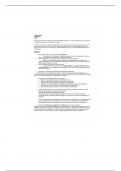Review Sheet
COMM 100
Exam 1
The midterm exam is 50 multiple choice and true/false questions. You will be required to fill in a scantron
so please bring a #2 pencil and your own eraser.
The best way to use this guide is to download it as a word document and add the answers for each one
as part of your studying. You can find the answers to each question in the lecture slides and the text
book. From there, you can quiz yourself or create flashcards to help you recall the information and build
associations.
Chapter 1:
• What does it mean the communication is functional?
Communication is functional as it helps or prevents us from reaching a goal. It helps us
improve our experiences and interactions making it functional.
• How can effective communication help your personal and professional life?
Effective communication helps our personal and professional life by increasing our
professional skills, helps our relationships become better, and can help us increase our positivity
regarding self-image and ourselves.
• What are the three functions of communication?
Communication is functional as it can express affiliation, manage relationships, and
influence others. Communication gives us the ability to show how we feel, exchange symbols as
well as control ideas.
• What does a critical thinking approach to communication look like?
Critical thinking in communications is related to understanding and deciphering messages from
others. By critically thinking about what someone is asking, or looking for in communication, we can figure
out our own response and be able to effectively communicate.
• What are the six characteristics of communication?
1. Based on messages, encoding and decoding meaning
2. Symbolic, rely on symbols to help us create/convey messages
3. Transactional, needs participants to be able to communicate
4. Influence by society and context, our learning of symbols is based off of society/context
5. Non-intentional, can communicate information without verbally doing so
6. Multi-channeled, make choices on how we are able to communicate
• What are the three models of communication? What makes them different? Which one do we
generally accept right now as the best explanation?
Linear Model: sender sends message to receiver
Transactional: recognizes transmitting messages (feedback), then sends new message
Synergetic Model: recognizes feedback and takes into account how society/context impact that
message.
Linear is different than the rest because it doesn’t take into consideration the role of feedback, the
sign of ongoing process of communication, as well as context. Transactional model takes into
consideration the concept of feedback but not how society/context impact our messages.
• What are the individual, situational and cultural contexts of communication?
Individual context of communication relates to our characteristics such as age, race, nationality, etc. This
relates to communication because individual factors like personality or physical ability influences how we
communicate with others. Situational context includes the social environment such as physical space or
specific events such as weddings or a home. Cultural context relates to the learned patterns of
, communication based on perceptions and values in the culture. This influences communication by
changing our language to fit different settings.
• Where do ethics come from?
Ethics are moral choices we make to describe the standards of right and wrong. Individuals gain ethics
through what society expects from us, as well as culture and norms.
• What is competent communications?
Competent communication is when communicators are effective and appropriate. This allows
communication to be competent because it gets the message across with a goal in mind and is
appropriate in context at the same time.
• Why do communicators need to be flexible?
Communicators must be flexible to adapt to different or new situations that communication takes
place in. It is more important to have flexible behavior and evaluate/reassess ways of
communication.
• Be able to name some things that comprise effective communication.
Things like lying, being harmful, or how relative your ethics are can compromise one’s
communication. People rely on messages to be truthful, as well as revealing/keeping information
that could be important also can compromise effective communication. Being mean/harmful with
communication also ruins it, as well as morality plays a role in determining if it’s effective.
Chapter 2:
• Identify the three main areas of research the influence communication research.
Rhetoric, Sociology, and Psychology all influence communication research. Rhetoric, the study of
language, helps us understand the shared code/language of communication. Sociology, the study of how
society works, helps us understand the social and cultural context of our communication. Psychology, the
study of behavior, explains how we interact with others.
• What are theories of communication? What are we trying to achieve by using them?
Theories are statements that explain a particular phenomenon, while paradigms are a belief system that
provides assumptions about human nature. Theories and paradigms regarding communication is an
attempt at understanding perspectives and experiences of individuals and groups. It helps us analyze
data and make connections.
• What’s the difference between quantitative and qualitative research methods? Be able to
identify each.
Quantitative is a statistical measurement of data, where data is converted into numbers for
statistics and analyzing. Things like surveys, questionnaires, and big trends are easy to put into
data. Qualitative research is based off of quality of data and analyzes data as natural conversion
and provides insight on research. These are more complex, by using interviews and content as
ways of research.
• What are three approaches to communication research? Be able to identify when each would be
useful for a specific study.
The three approaches are social science, interpretive, and critical. Social science relates to
communication looked at behavior between people as they interact. This focuses on how people
react, observes how secure/alone one is, or how stable.




